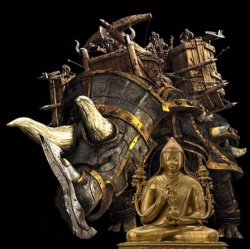Difference between revisions of "Trongjug"
(Created page with "{{DisplayImages|2074}} ===Trongjug: The Transference of Consciousness=== A corpse can be taken by an evil spirit and become a rolang, but a body may also ...") |
|||
| Line 2: | Line 2: | ||
===Trongjug: The [[Transference]] of [[Consciousness]]=== | ===Trongjug: The [[Transference]] of [[Consciousness]]=== | ||
| − | A corpse can be taken by an [[evil spirit]] and become a [[rolang]], but a [[body]] may also be taken by a living [[Tibetan]] [[master]] through the practice of trongjug. The great [[Nyingma]] [[master]] H.H. | + | A corpse can be taken by an [[evil spirit]] and become a [[rolang]], but a [[body]] may also be taken by a living [[Tibetan]] [[master]] through the practice of trongjug. The great [[Nyingma]] [[master]] H.H. [[Dilgo Khyentse Rinpoche]] explained that “the practice of [[transference]] is quite special. If someone is very old and will not live much longer, but still wishes to continue his [[dharma practice]] and help others, then he can enter a fresh corpse that is young, strong, and healthy” ([[Heruka]] 1986, p. 94). [[Khenpo Pema Sherab]] (Interview April 5, 2000) recounted that “a long [[time]] ago when [[people]] would [[die]], an old man who was honest and good would transfer into a young corpse” to avoid the disruption of one’s [[consciousness]] which occurs when transfering from one [[life]] to the next. |
Allegedly, trongjug is no longer practiced today. [[Ngakpa]] [[Karma]] Londrup (Interview May 4, 2000) noted that the [[transmission]] from [[teacher]] to student has been disrupted and so the [[lineage]] of that [[teaching]] did not continue. He was referring specifically to the [[time]] of [[Marpa Lotsawa]], a great [[Tibetan]] [[master]]. [[Marpa]] obtained [[secret oral instructions]] on the ejection and [[transference of consciousness]] ([[phowa]] and trongjug) from his [[master]] [[Naropa]] ([[Heruka]] 1996, p. 155). [[Marpa]] transmitted these secret [[doctrines]] to his son Tarma Dode, who later [[died]] suddenly. In [[Marpa’s]] {{Wiki|biography}} it is explained that “since the instructions of the ejection and [[transference of consciousness]] that bring [[enlightenment]] without [[effort]] in [[meditation]] were not destined to spread in [[Tibet]], they could not find even one {{Wiki|male}} corpse without a wound” ([[Heruka]] 1986, p. 171). | Allegedly, trongjug is no longer practiced today. [[Ngakpa]] [[Karma]] Londrup (Interview May 4, 2000) noted that the [[transmission]] from [[teacher]] to student has been disrupted and so the [[lineage]] of that [[teaching]] did not continue. He was referring specifically to the [[time]] of [[Marpa Lotsawa]], a great [[Tibetan]] [[master]]. [[Marpa]] obtained [[secret oral instructions]] on the ejection and [[transference of consciousness]] ([[phowa]] and trongjug) from his [[master]] [[Naropa]] ([[Heruka]] 1996, p. 155). [[Marpa]] transmitted these secret [[doctrines]] to his son Tarma Dode, who later [[died]] suddenly. In [[Marpa’s]] {{Wiki|biography}} it is explained that “since the instructions of the ejection and [[transference of consciousness]] that bring [[enlightenment]] without [[effort]] in [[meditation]] were not destined to spread in [[Tibet]], they could not find even one {{Wiki|male}} corpse without a wound” ([[Heruka]] 1986, p. 171). | ||
Revision as of 08:07, 23 March 2014
Trongjug: The Transference of Consciousness
A corpse can be taken by an evil spirit and become a rolang, but a body may also be taken by a living Tibetan master through the practice of trongjug. The great Nyingma master H.H. Dilgo Khyentse Rinpoche explained that “the practice of transference is quite special. If someone is very old and will not live much longer, but still wishes to continue his dharma practice and help others, then he can enter a fresh corpse that is young, strong, and healthy” (Heruka 1986, p. 94). Khenpo Pema Sherab (Interview April 5, 2000) recounted that “a long time ago when people would die, an old man who was honest and good would transfer into a young corpse” to avoid the disruption of one’s consciousness which occurs when transfering from one life to the next.
Allegedly, trongjug is no longer practiced today. Ngakpa Karma Londrup (Interview May 4, 2000) noted that the transmission from teacher to student has been disrupted and so the lineage of that teaching did not continue. He was referring specifically to the time of Marpa Lotsawa, a great Tibetan master. Marpa obtained secret oral instructions on the ejection and transference of consciousness (phowa and trongjug) from his master Naropa (Heruka 1996, p. 155). Marpa transmitted these secret doctrines to his son Tarma Dode, who later died suddenly. In Marpa’s biography it is explained that “since the instructions of the ejection and transference of consciousness that bring enlightenment without effort in meditation were not destined to spread in Tibet, they could not find even one male corpse without a wound” (Heruka 1986, p. 171).
In one well known story, the Indian pandit Shankaracharya, was challenged to a debate on sensual love. Being celibate, he was at a disadvantage. The idea then came to him to practice transference, and he assumed the body of a recently deceased king. The king’s body arose and he called all his handmaidens and consorts to his bedroom, where his lessons commenced. Returning to his own body the next day, Shankaracharya was then in a position to argue and win the debate (Evans-Wentz 1958, p. 257).
Abuses of such a highly developed tantric practice are further illustrated by the story of a prince and his servant who both knew the practice of trongjug. One day the prince transferred his consciousness, out of compassion, into a mother bird which he had seen die, so that he could feed its chicks. He asked the servant to watch over his deserted body, but the servant who was attracted to the prince’s wife, took the prince’s body. The prince then had no choice but to take the body of the servant (Khenpo Pema Sherab, Interview May 4, 2000).
